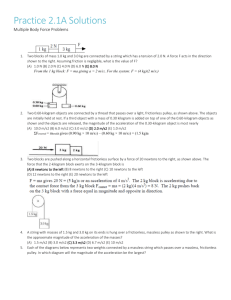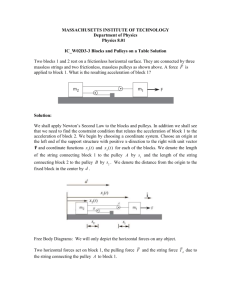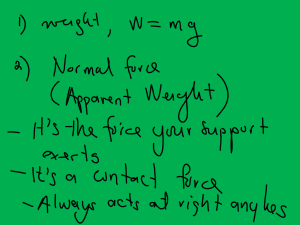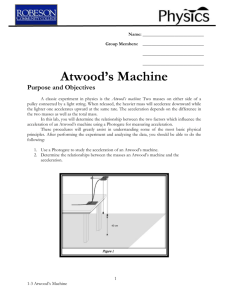Atwood/SBA PP - Plain Local Schools
advertisement
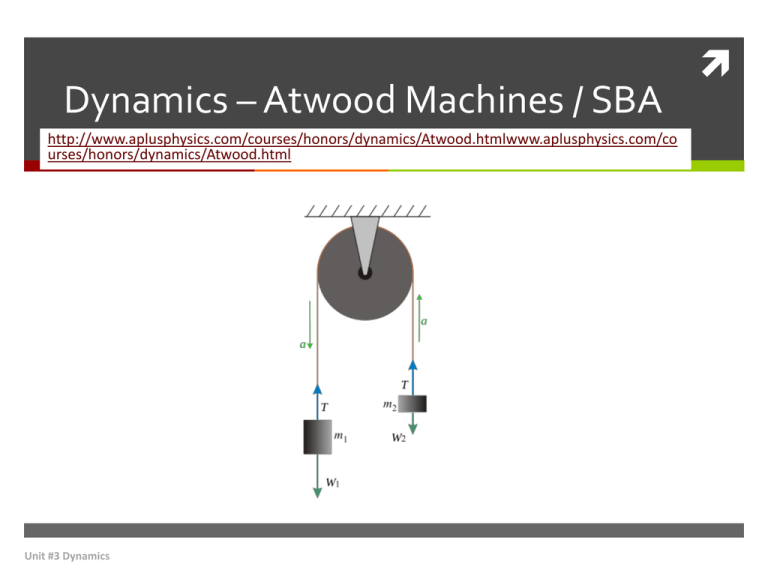
Dynamics – Atwood Machines / SBA http://www.aplusphysics.com/courses/honors/dynamics/Atwood.htmlwww.aplusphysics.com/co urses/honors/dynamics/Atwood.html Unit #3 Dynamics Objectives and Learning Targets Resolve a vector into perpendicular components: both graphically and algebraically. Use vector diagrams to analyze mechanical systems (equilibrium and non-equilibrium). Analyze and solve basic Atwood Machine problems using Newton’s 2nd Law of Motion. Unit #3 Dynamics Atwood Machines An Atwood Machine is a basic physics laboratory device often used to demonstrate basic principles of dynamics and acceleration. The machine typically involves a pulley, a string, and a system of masses. Keys to solving Atwood Machine problems are recognizing that the force transmitted by a string or rope, known as tension, is constant throughout the string, and choosing a consistent direction as positive. Let’s walk through an example to demonstrate. Unit #3 Dynamics Sample Problem #1 Question: Two masses, m1 and m2, are hanging by a massless string from a frictionless pulley. If m1 is greater than m2, determine the acceleration of the two masses when released from rest. Unit #3 Dynamics Sample Problem #1 Question: Two masses, m1 and m2, are hanging by a massless string from a frictionless pulley. If m1 is greater than m2, determine the acceleration of the two masses when released from rest. Answer: First, identify a direction as positive. Since you can easily observe that m1 will accelerate downward and m2 will accelerate upward, since m1 > m2, call the direction of motion around the pulley and down toward m1 the positive y direction. Then, you can create free body diagrams for both object m1 and m2, as shown below: Unit #3 Dynamics Sample Problem #1 Using this diagram, write Newton’s 2nd Law equations for both objects, taking care to note the positive y direction: Next, combine the equations and eliminate T by solving for T in equation (2) and substituting in for T in equation (1). Unit #3 Dynamics Sample Problem #1 Finally, solve for the acceleration of the system. Unit #3 Dynamics Sample Problem #1 (Alternate Solution) Alternately, you could treat both masses as part of the same system. Drawing a dashed line around the system, you can directly write an appropriate Newton’s 2nd Law equation for the entire system. *Note that if the string and pulley were not massless, this problem would become considerably more involved. Unit #3 Dynamics Single Body Analysis (SBA) Steps General Problem Solving Guidelines (there are exceptions) 1. Draw the situation described including all of the applicable forces. 2. Create Newton’s Second Law expressions for each object in your diagrams. (ma=winner(s)-loser(s)) 3. Solve the expressions for the same variable (i.e. tension) and set them equal to each other. 4. Solve for the unknown variable. 5. Use your newly found variable to go back and find any others that you need. Unit #3 Dynamics SBA Calculator Tips Method for using your calculator to find “a” and “T” in a two object system 1. Follow steps 1-3 listed above 2. Hit [Y=] and enter the first equation on the “Y1” line, hit [ENTER] 3. Enter your second equation on the “Y2” line, hit [2nd] [CALC] 4. Hit [5] for “intersect” hit [ENTER] three times. 5. The value displayed for x is the tension if your equations were solved for tension, and y is the acceleration. (If your equations were solved for acceleration the opposite is true) Unit #3 Dynamics SBA Sample Problems ***All example problems use a frictionless, massless pulley under ideal conditions. Air resistance should be considered negligible (0N). 1. A 1 kg mass is suspended by a (ideal) pulley system with a string that is attached to a 9 kg mass. The 9 kg mass is on a frictionless table (mu = 0). Solve for the acceleration (a) of the system and the tension (T) on each mass. 2. A 2 kg mass is suspended by a (ideal) pulley system with a string that is attached to a 3 kg mass. The 3 kg mass is on a table with a mu value of 0.50. Solve for the acceleration (a) of the system and the tension (T) on each mass. 3. A 5.00 kg mass is suspended by a (ideal) pulley system with a string that is attached to a 4.00 kg mass. The 5.00 kg mass is on a table with a mu value of 0.40. Solve for the acceleration (a) of the system and the tension (T) on each mass. 4. A 2.0 kg mass is suspended by a (ideal) pulley system with a string that is attached to an 8.0 kg mass. The 8.0 kg mass is on a table with a mu value of 0.200. Solve for the acceleration (a) of the system and the tension (T) on each mass. 5. A 7.00 kg mass is suspended by a (ideal) pulley system with a string that is attached to a 5.00 kg mass. The 5.00 kg mass is on a table with a mu value of 0.50. Solve for the acceleration (a) of the system and the tension (T) on each mass. Unit #3 Dynamics
